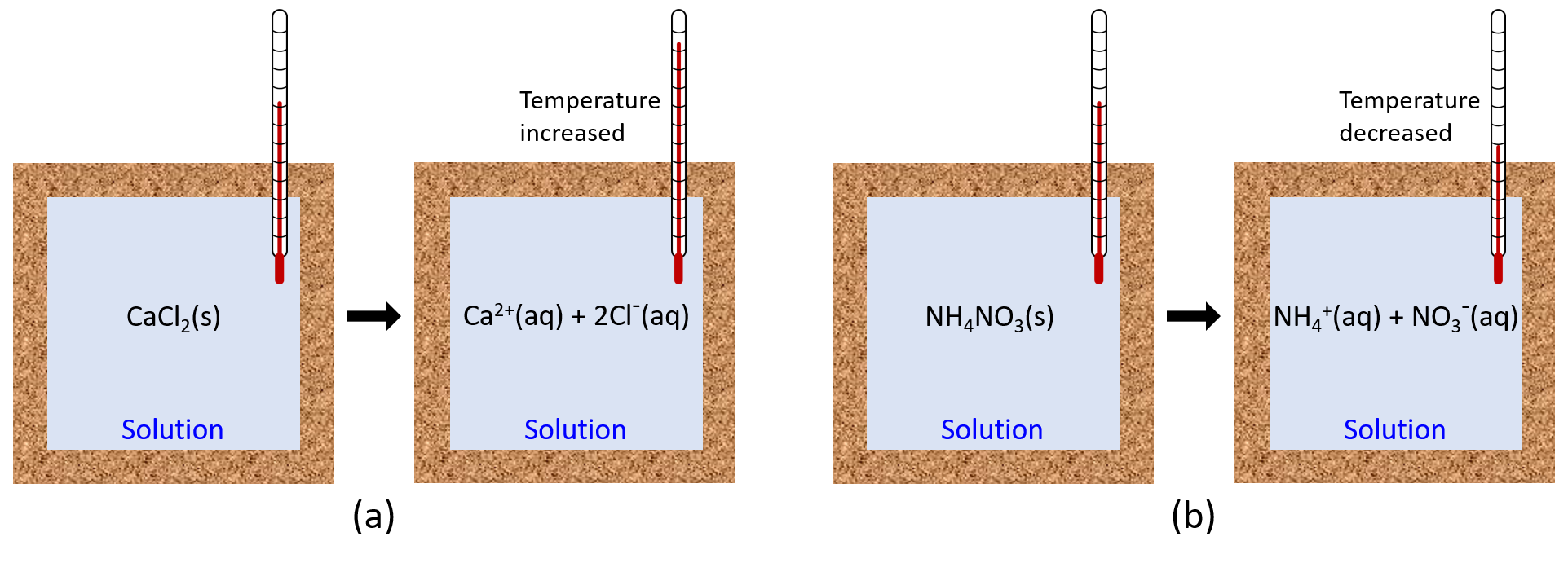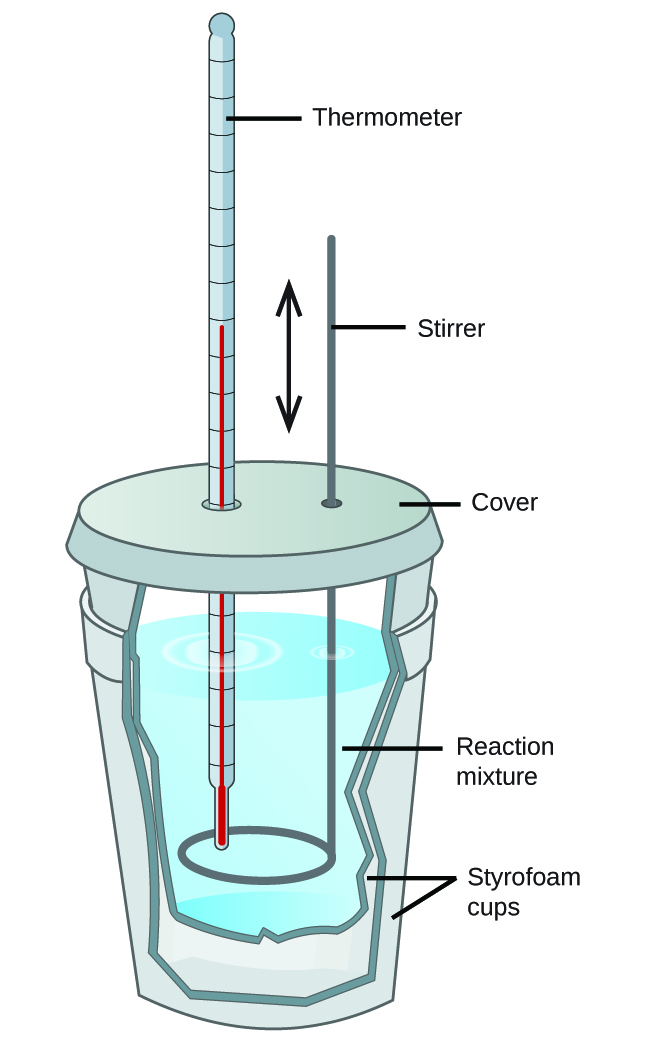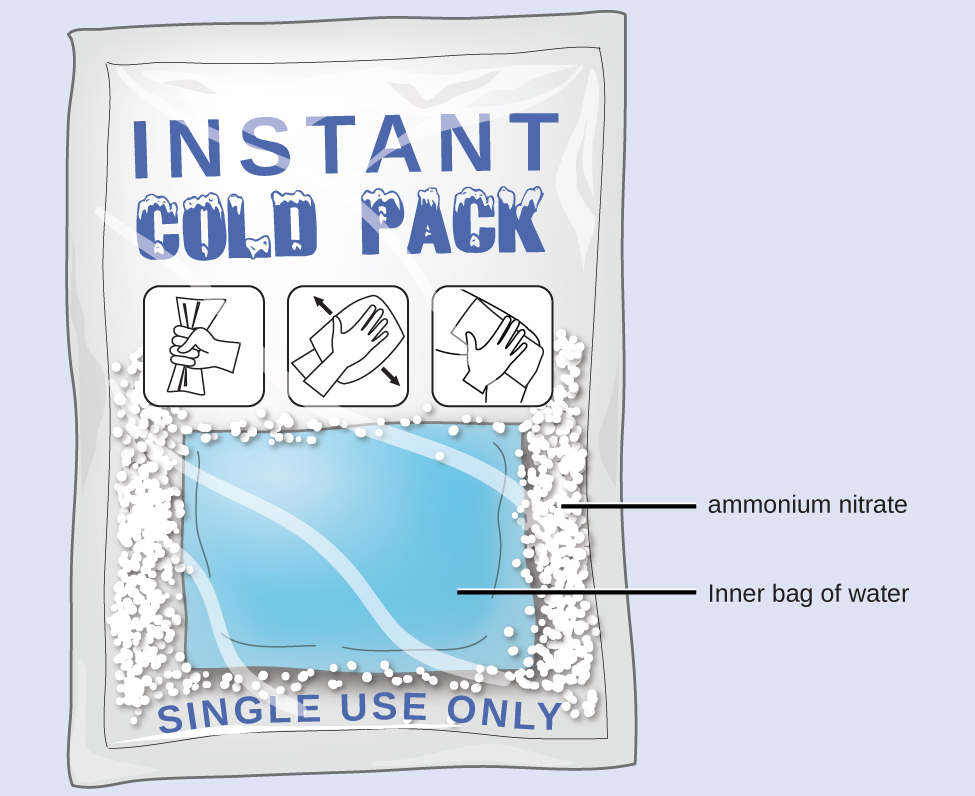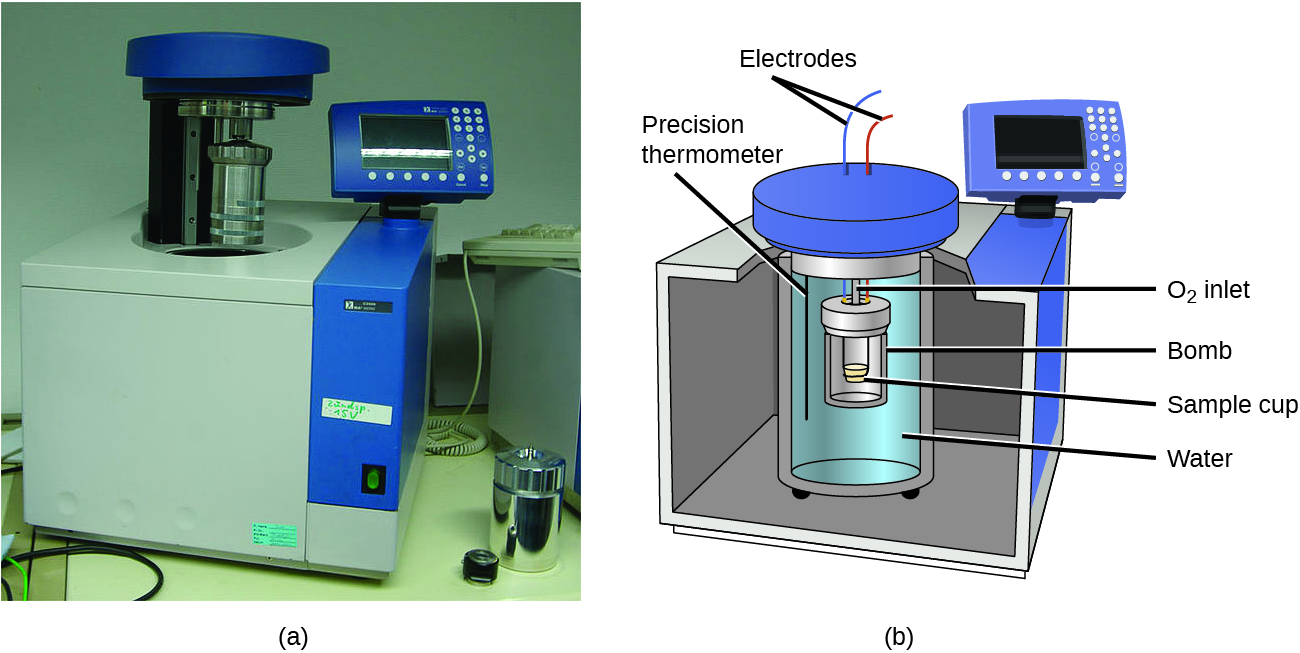30 Calorimetry continued: Types of Calorimeters and Analyzing Heat Flow (M6Q5)
Introduction
Learning Objectives for Calorimetry: Types of Calorimeters and Analyzing Heat Flow
- Identify the relationship between heat, mass, temperature change, and heat capacities and solve problems that quantify heat flow.
| Calorimeters | Coffee Cup Calorimetry | Heat Flow When Hot Metals are Placed in Water | Heat Flow When Chemical Reactions Occur | Bomb Calorimetry |
| Key Concepts and Summary | Key Equations | Glossary | End of Section Exercises |
Calorimeters
One technique we can use to measure the amount of heat involved in a chemical or physical process is known as calorimetry. Calorimetry is used to measure amounts of heat transferred to or from a substance. To do so, a calorimeter is used. A calorimeter is a calibrated object that has a known heat capacity, which relates temperature change to heat flow. In a calorimetry experiment, heat is transferred between a substance and a calorimeter, and the change in temperature of the calorimeter is converted into the amount of heat. The measurement of heat transfer using this approach requires the definition of a system (the substance or substances undergoing the chemical or physical change) and its surroundings (the other components of the measurement apparatus that serve to either provide heat to the system or absorb heat from the system). Knowledge of the heat capacity of the surroundings, and careful measurements of the masses of the system and surroundings and their temperatures before and after the process, allows one to calculate the heat transferred as described in this section.
A calorimeter is a device used to measure the amount of heat involved in a chemical or physical process. For example, when an exothermic reaction occurs in solution in a calorimeter, the heat produced by the reaction is absorbed by the solution, which increases the solution's temperature. When an endothermic reaction occurs, the heat required is absorbed from the thermal energy of the solution, which decreases the solution's temperature (Figure 1). The temperature change, along with the specific heat and mass of the solution, can then be used to calculate the amount of heat involved in either case.

Before we practice calorimetry problems involving chemical reactions, consider a simpler example that illustrates the core idea behind calorimetry. Suppose we initially have a high-temperature substance, such as a hot piece of metal (M), and a low-temperature substance, such as cool water (W). If we place the metal in the water, heat will flow from metal (M) to water (W). The temperature of the metal will decrease, and the temperature of the water will increase, until the two substances have the same temperature—that is, when they reach thermal equilibrium (Figure 2). If this occurs in a calorimeter, ideally all of this heat transfer occurs between the two substances, with no heat gained or lost by either the calorimeter or the calorimeter’s surroundings. Under these ideal circumstances, the net heat change is zero:
This relationship can be rearranged to show that the heat gained by substance M is equal to the heat lost by substance W:
The magnitude of the heat (change) is therefore the same for both substances, and the negative sign merely shows that qmetal and qwater are opposite in direction of heat flow (gain or loss) but does not indicate the arithmetic sign of either q value (that is determined by whether the matter in question gains or loses heat, per definition). In the specific situation described, qmetal is a negative value and qwater is positive, since heat is transferred from metal to water.

Coffee Cup Calorimetry
Scientists use well-insulated calorimeters to minimize the transfer of heat between the calorimeter and its environment. This enables the accurate determination of the heat involved in chemical processes, the energy content of foods, and so on. Relatively inexpensive calorimeters often consist of two thin-walled cups that are nested in a way that minimizes thermal loss during use, along with an insulated cover, handheld stirrer, and simple thermometer (Figure 3). Many general chemistry labs utilize such coffee cup calorimeters because they are inexpensive and easy to use. The amount of heat absorbed by the calorimeter is often small enough that we can neglect it. These types of calorimeters operate at constant pressure as the lid is not an air-tight seal and the system is effectively still open to the atmosphere. Since the heat flow that is measured in this case is the heat flow at constant pressure, qp, this type of calorimeter provides a direct way to find the enthalpy change of the process, ΔH, since ΔH = qp.

Commercial solution calorimeters are also available and more expensive. Calorimeters used for industry and research typically have a well-insulated, fully enclosed reaction vessel, motorized stirring mechanism, and a more accurate temperature sensor.
Heat flow when hot metals are placed in water
We can use a calorimeter to analyze the heat exchanged when two substances at different temperatures are brought into contact. When hot metals are brought into contact with cool water, heat will flow until both the metal and water (the system) obtain the same final temperature. If the experiment it conducted within a calorimeter, then heat lost to matter outside the calorimeter (the surroundings) is essentially zero, and can be expressed as:
qsystem = 0 = qhot metal + qwater
Thus, as the system comes to equilibrium, the heat lost as the metal cools is equal in magnitude and opposite in sign to the heat gained as the water warms.
qhot metal = -qwater
Example 1
Heat Transfer between Substances at Different Temperatures
A 360-g piece of rebar (a steel rod used for reinforcing concrete) is dropped into 425 mL of water at 24.0 °C. The final temperature of the water was measured as 42.7 °C. Calculate the initial temperature of the piece of rebar. Assume the specific heat of steel is approximately the same as that for iron (Specific Heat Table), and that all heat transfer occurs between the rebar and the water (there is no heat exchange with the surroundings).
Solution
The temperature of the water increases from 24.0 °C to 42.7 °C, so the water absorbs heat. That heat came from the piece of rebar, which initially was at a higher temperature. Assuming that all heat transfer was between the rebar and the water, with no heat “lost” to the surroundings, then heat given off by rebar = −heat taken in by water, or:
Since we know how heat is related to other measurable quantities, we have:
Letting f = final and i = initial, in expanded form, this becomes:
The density of water is 1.0 g/mL, so 425 mL of water = 425 g. Noting that the final temperature of both the rebar and water is 42.7 °C, substituting known values yields:
(0.449 J/(g °C))(360 g)(42.7 °C - Ti, rebar) = (4.184 J/(g °C))(425 g)(42.7 °C - 24.0 °C)
Ti, rebar = [latex]\frac{(4.184\;\text{J/g} \;^\circ\text{C})(425 \;\text{g})(42.7 \;^\circ\text{C} - 24.0 \;^\circ\text{C})}{(0.449 \;\text{J/g} \;^\circ\text{C})(360 \;\text{g})}[/latex] + 42.7 °C
Solving this gives Ti, rebar = 248 °C, so the initial temperature of the rebar was 248 °C.
Check Your Learning
A 248-g piece of copper is dropped into 390 mL of water at 22.6 °C. The final temperature of the water was measured as 39.9 °C. Calculate the initial temperature of the piece of copper. Assume that all heat transfer occurs between the copper and the water.
Answer:
The initial temperature of the copper was 335.6 °C.
This method can also be used to determine other quantities, such as the specific heat of an unknown metal.
Example 2
Identifying a Metal by Measuring Specific Heat
A 59.7 g piece of metal that had been submerged in boiling water was quickly transferred into 60.0 mL of water initially at 22.0 °C. The final temperature is 28.5 °C. Use these data to determine the specific heat of the metal. Use this result to identify the metal.
Solution
Assuming perfect heat transfer, heat given off by metal = −heat taken in by water, or:
In expanded form, this is:
Noting that since the metal was submerged in boiling water, its initial temperature was 100.0 °C; and that for water, 60.0 mL = 60.0 g; we have:
Solving this:
Comparing this with values in the Specific Heats Table, our experimental specific heat is closest to the value for copper (0.39 J/(g °C)), so we identify the metal as copper.
Check Your Learning
A 92.9-g piece of a silver/gray metal is heated to 178.0 °C, and then quickly transferred into 75.0 mL of water initially at 24.0 °C. After 5 minutes, both the metal and the water have reached the same temperature: 29.7 °C. Determine the specific heat and the identity of the metal. (Note: You should find that the specific heat is close to that of two different metals. Explain how you can confidently determine the identity of the metal).
Answer:
cmetal = 0.13 J/(g °C)
This specific heat is close to that of either gold or lead. It would be difficult to determine which metal this was based solely on the numerical values. However, the observation that the metal is silver/gray in addition to the value for the specific heat indicates that the metal is lead.
Heat flow when chemical reactions occur
When we use calorimetry to determine the heat involved in a chemical reaction, the same principles we have been discussing apply. Because energy is neither created nor destroyed during a chemical reaction, there is no overall energy change during the reaction. The heat produced or consumed in the reaction (the system), qreaction, plus the heat absorbed or lost by the solution (the surroundings), qsolution, must add up to zero:
qreaction + qsolution = 0
This means that the amount of heat produced or consumed in the reaction equals the amount of heat absorbed or lost by the solution:
qreaction = -qsolution
This equation will be extremely useful with heat-transfer related problems.
Demonstration: Heat of neutralization reaction
Set up. The following demonstration illustrates using calorimetry to measure the heat of the neutralization reaction between HCl and NaOH. First, HCl is added to an insulated container and the temperature probe is placed into the solution. An initial temperature reading is recorded on the computer. The lid is briefly lifted and the NaOH is added. The lid is then quickly replaced and the temperature change is observed.
Prediction. Before watching the video, write the reaction equation for this neutralization reaction.
Explanation. The reaction occurring here is:
HCl(aq) + NaOH(aq) → H2O(l) + NaCl(aq)
The initial temperature reading of the HCl was stabilized at 22.4 °C. When the NaOH is added, the temperature of the solution increases to 66.3 °C. Since the temperature of the solution increased, we know that the qsolution is positive (positive ΔT) and therefore the qreaction must be negative. This indicates that the reaction is an exothermic reaction. An exothermic reaction releases energy and thus increases the temperature of the solution.
Note: If you look closely at the temperature reading at the end of the video, you'll notice that the temperature reaches a maximum of 66.3 °C, but then starts to decrease again and reaches 65.7 °C at the end of the video. This decrease in temperature that happens after the reaction occurs is due to heat escaping from the insulated container. When you perform similar experiments in the lab, you will want to note the highest (or lowest) temperature reached for the reaction since imperfect insulation of the container causes the temperature to drop (or increase) after the reaction is completed and is not a result of the thermochemistry of the reaction being studied.
Example 3
Heat Produced by an Exothermic Reaction
When 50.0 mL of 0.10 M HCl(aq) and 50.0 mL of 0.10 M NaOH(aq), both at 22.0 °C, are added to a coffee cup calorimeter, the temperature of the mixture reaches a maximum of 28.9 °C. What is the approximate amount of heat produced by this reaction?
Solution
To visualize what is going on, imagine that you could combine the two solutions so quickly that no reaction took place while they mixed; then after mixing, the reaction took place. At the instant of mixing, you have 100.0 mL of a mixture of HCl and NaOH at 22.0 °C. The HCl and NaOH then react until the solution temperature reaches 28.9 °C.
The heat given off by the reaction is equal to that taken in by the solution. Therefore:
(It is important to remember that this relationship only holds if the calorimeter does not absorb any heat from the reaction, and there is no heat exchange between the calorimeter and its surroundings.)
Next, we know that the heat absorbed by the solution depends on its specific heat, mass, and temperature change:
To proceed with this calculation, we need to make a few more reasonable assumptions or approximations. Since the solution is aqueous, we can proceed as if it were water in terms of its specific heat and mass values. The density of water is approximately 1.0 g/mL, so 100.0 mL has a mass of about 1.0 × 102 g (two significant figures). The specific heat of water is approximately 4.18 J/g °C, so we use that for the specific heat of the solution. Substituting these values gives:
Finally, since we are trying to find the heat of the reaction, we have:
The negative sign indicates that the reaction is exothermic. It produces 2.89 kJ of heat.
Check Your Learning
When 100 mL of 0.200 M NaCl(aq) and 100 mL of 0.200 M AgNO3(aq), both at 21.9 °C, are mixed in a coffee cup calorimeter, the temperature increases to 23.5 °C as solid AgCl forms. How much heat is produced by this precipitation reaction? What assumptions did you make to determine your value?
Answer:
1.34 × 103 J; assume no heat is absorbed by the calorimeter, no heat is exchanged between the calorimeter and its surroundings, and that the specific heat and mass of the solution are the same as those for water
Chemistry in Real Life: Thermochemistry of Hand Warmers
When working or playing outdoors on a cold day, you might use a hand warmer to warm your hands (Figure 4). A common reusable hand warmer contains a supersaturated solution of NaC2H3O2 (sodium acetate) and a metal disc. Bending the disk creates nucleation sites around which the metastable NaC2H3O2 quickly crystallizes (a later chapter on solutions will investigate saturation and supersaturation in more detail).
The process NaC2H3O2(aq) → NaC2H3O2(s) is exothermic, and the heat produced by this process is absorbed by your hands, thereby warming them (at least for a while). If the hand warmer is reheated, the NaC2H3O2 redissolves and can be reused.

Another common hand warmer produces heat when it is ripped open, exposing iron and water in the hand warmer to oxygen in the air. One simplified version of this exothermic reaction is 2Fe(s) + [latex]\frac{3}{2}[/latex]O2(g) → Fe2O3(s). Salt in the hand warmer catalyzes the reaction, so it produces heat more rapidly; cellulose, vermiculite, and activated carbon help distribute the heat evenly. Other types of hand warmers use lighter fluid (a platinum catalyst helps lighter fluid oxidize exothermically), charcoal (charcoal oxidizes in a special case), or electrical units that produce heat by passing an electrical current from a battery through resistive wires.

This link shows the precipitation reaction that occurs when the disk in a chemical hand warmer is flexed.
Example 4
Heat Flow in an Instant Ice Pack
When solid ammonium nitrate dissolves in water, the solution becomes cold. This is the basis for an “instant ice pack” (Figure 5). When 3.21 g of solid NH4NO3 dissolves in 50.0 g of water at 24.9 °C in a calorimeter, the temperature decreases to 20.3 °C.
Calculate the value of q for this reaction and explain the meaning of its arithmetic sign. State any assumptions that you made.

Solution
We assume that the calorimeter prevents heat transfer between the solution and its external environment (including the calorimeter itself), in which case:
with “rxn” and “soln” used as shorthand for “reaction” and “solution,” respectively.
Assuming also that the specific heat of the solution is the same as that for water, we have:
= -[(4.184 J/(g °C)) × (53.2 g) × (20.3 °C - 24.9 °C)]
= -[(4.184 J/(g °C)) × (53.2 g) × (-4.6 °C)]
= +1.0 × 103 J = +1.0 kJ
The positive sign for q indicates that the dissolution is an endothermic process.
Check Your Learning
When a 3.00-g sample of KCl was added to 3.00 × 102 g of water in a coffee cup calorimeter, the temperature decreased by 1.05 °C. How much heat is involved in the dissolution of the KCl? What assumptions did you make?
Answer:
1.33 kJ; assume that the calorimeter prevents heat transfer between the solution and its external environment (including the calorimeter itself) and that the specific heat of the solution is the same as that for water
Bomb Calorimetry: Constant Volume Work
If the amount of heat absorbed by a calorimeter is too large to neglect or if we require more accurate results, then we must take into account the heat absorbed both by the solution and by the calorimeter.
Bomb calorimeter operates at constant volume, and these calorimeters are used to measure the energy produced by reactions that yield large amounts of heat and gaseous products, such as combustion reactions. (The term “bomb” comes from the observation that these reactions can be vigorous enough to resemble explosions that would damage other calorimeters. Clearly, the last thing one would wish to happen is for the actual calorimeter to explode due to excessive pressure build up, so the "bomb" is a robust steel container that contains the reactants and is itself submerged in water (Figure 6). The sample is placed in the bomb, which is then filled with oxygen at high pressure. A small electrical spark is used to ignite the sample. The energy produced by the reaction is trapped in the steel bomb and the surrounding water. The temperature increase is measured and, along with the known heat capacity of the calorimeter, is used to calculate the energy produced by the reaction. Bomb calorimeters require calibration to determine the heat capacity of the calorimeter and ensure accurate results. The calibration is accomplished using a reaction with a known q, such as a measured quantity of benzoic acid ignited by a spark from a nickel fuse wire that is weighed before and after the reaction. The temperature change produced by the known reaction is used to determine the heat capacity of the calorimeter. The calibration is generally performed each time before the calorimeter is used to gather research data.

Key Concepts and Summary
Calorimeters are designed to minimize energy exchange between the system being studied and its surroundings. They range from simple coffee cup calorimeters used by introductory chemistry students to sophisticated bomb calorimeters used to determine the energy content of food. The main goal of calorimetry is to determine the heat flow. If an endothermic reaction occurs in a coffee cup calorimeter, the temperature of the surrounding solution would decrease because thermal energy from the solution is absorbed by the reaction. If an exothermic reaction occurs in a coffee cup calorimeter, the temperature of the surrounding solution would increase as it absorbs the released thermal energy. Heat stops flowing when thermal equilibrium is reached and everything in the system is the same temperature.
Key Equations
- qreaction + qsolution = 0
Glossary
- bomb calorimeter
- device designed to measure the energy change for processes occurring under conditions of constant volume; commonly used for combustion reactions
- calorimeter
- device used to measure the amount of heat absorbed or released in a chemical or physical process
- calorimetry
- process of measuring the amount of heat involved in a chemical or physical process
Chemistry End of Section Exercises
- How many milliliters of water at 23 °C with a density of 1.00 g/mL must be mixed with 180 mL (about 6 oz) of coffee at 95 °C so that the resulting combination will have a temperature of 60 °C? Assume that coffee and water have the same density and the same specific heat.
- A 45-g aluminum spoon (specific heat 0.88 J/g °C) at 24 °C is placed in 180 mL (180 g) of coffee at 85 °C and the temperature of the two become equal.
- What is the final temperature when the two become equal? Assume that coffee has the same specific heat as water.
- The first time a student solved this problem she got an answer of 88 °C. Explain why this is clearly an incorrect answer.
- The temperature of the cooling water as it leaves the hot engine of an automobile is 240 °F. After it passes through the radiator it has a temperature of 175 °F. Calculate the amount of heat transferred (in kJ) from the engine to the surroundings by one gallon of water with a specific heat of 4.184 J/g °C.
- A 70.0-g piece of metal at 80.0 °C is placed in 100 g of water at 22.0 °C contained in a calorimeter like that shown in Figure 3. The metal and water come to the same temperature at 24.6 °C. How much heat did the metal give up to the water? What is the specific heat of the metal?
- If a reaction produces 1.506 kJ of heat, which is trapped in 30.0 g of water initially at 26.5 °C in a calorimeter like that in Figure 3, what is the resulting temperature of the water (in °C)?
- Dissolving 3.0 g of CaCl2(s) in 150.0 g of water in a calorimeter (Figure 3) at 22.4 °C causes the temperature to rise to 25.8 °C. What is the approximate amount of heat (in kJ) involved in the dissolution, assuming the heat capacity of the resulting solution is 4.18 J/g °C? Is the reaction exothermic or endothermic?
- When 50.0 g of 0.200 M NaCl(aq) at 24.1 °C is added to 100.0 g of 0.100 M AgNO3(aq) at 24.1 °C in a calorimeter, the temperature increases to 25.2 °C as AgCl(s) forms. Assuming the specific heat of the solution and products is 4.20 J/g °C, calculate the approximate amount of heat in joules produced.
- The addition of 3.15 g of Ba(OH)2·8H2O to a solution of 1.52 g of NH4SCN in 100 g of water in a calorimeter caused the temperature to fall by 3.1 °C. Assuming the specific heat of the solution and products is 4.20 J/g °C, calculate the approximate amount of heat (in kJ) absorbed by the reaction, which can be represented by the following equation:
Ba(OH)2·8H2O(s) + 2NH4SCN(aq) ⟶ Ba(SCN)2(aq) + 2NH3(aq) + 10H2O(l)
- The reaction of 50 mL of acid and 50 mL of base described in Example 3 increased the temperature of the solution by 6.9 degrees. How much would the temperature have increased if 100 mL of acid and 100 mL of base had been used in the same calorimeter starting at the same temperature of 22.0 °C? Explain your answer.
- If the 3.21 g of NH4NO3 in Example 4 were dissolved in 100.0 g of water under the same conditions, how much would the temperature change? Explain your answer.
- When 1.0 g of fructose, C6H12O6(s), a sugar commonly found in fruits, is burned in oxygen in a bomb calorimeter, the temperature of the calorimeter increases by 1.58 °C. If the heat capacity of the calorimeter and its contents is 9.90 kJ/°C, what is q for this combustion?
- When a 0.740-g sample of trinitrotoluene (TNT), C7H5N2O6, is burned in a bomb calorimeter, the temperature increases from 23.4 °C to 26.9 °C. The heat capacity of the calorimeter is 534 J/°C, and it contains 675 mL of water. How much heat (in kJ) was produced by the combustion of the TNT sample?
- One method of generating electricity is by burning coal to heat water, which produces steam that drives an electric generator. To determine the rate at which coal is to be fed into the burner in this type of plant, the heat of combustion per ton of coal must be determined using a bomb calorimeter. When 1.00 g of coal is burned in a bomb calorimeter (Figure 6), the temperature increases by 1.48 °C. If the heat capacity of the calorimeter is 21.6 kJ/°C, determine the heat produced by combustion of a ton of coal (2.000 × 103 pounds).
- The amount of fat recommended for someone with a daily diet of 2000 Calories is 65 g. What percent of the calories in this diet would be supplied by this amount of fat if the average number of Calories for fat is 9.1 Calories/g?
- A teaspoon of the carbohydrate sucrose (common sugar) contains 16 Calories (16 kcal). What is the mass of one teaspoon of sucrose if the average number of Calories for carbohydrates is 4.1 Calories/g?
- What is the maximum mass of carbohydrate (in grams) in a 6-oz serving of diet soda that contains less than 1 Calorie per can if the average number of Calories for carbohydrates is 4.1 Calories/g?
- A pint of premium ice cream can contain 1100 Calories. What mass of fat, in grams and pounds, must be produced in the body to store an extra 1.1 × 103 Calories if the average number of Calories for fat is 9.1 Calories/g?
- A serving of a breakfast cereal contains 3 g of protein, 18 g of carbohydrates, and 6 g of fat. What is the Calorie content of a serving of this cereal if the average number of Calories for fat is 9.1 Calories/g, for carbohydrates is 4.1 Calories/g, and for protein is 4.1 Calories/g?
Answers to Chemistry End of Section Exercises
- 170 mL
- a) 82 °C; b) Because 88°C is higher than the starting temperatures of the coffee and the spoon, which is impossible.
- 5.7 × 102 kJ
- 1088 J; the specific heat of the metal is 0.28 J/g °C
- 38.5 °C
- 2.2 kJ; The heat produced shows that the reaction is exothermic.
- 693 J
- 1.4 kJ
- 6.9 °C; The total heat released would double because the volume (mass) doubled, ΔT would still be 6.9 °C.
- +2.3 °C. Since the mass and the heat capacity of the solution is approximately equal to that of the water, the two-fold increase in the amount of water leads to a two-fold decrease of the temperature change.
- q = -15.6 kJ
- 11.7 kJ
- q = -2.90 × 1010 J
- 30%
- 3.9 g
- 0.24 g
- 1.2 × 102 g; 0.26 pounds
- 1.4 × 102 Calories

